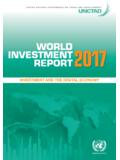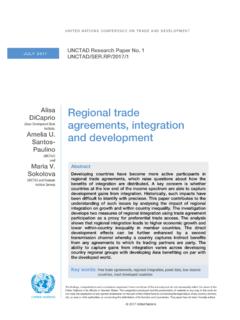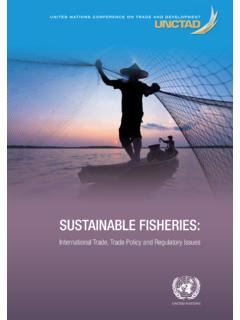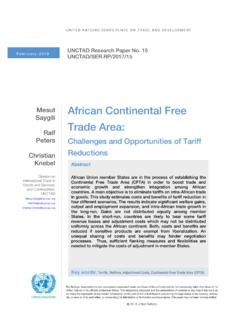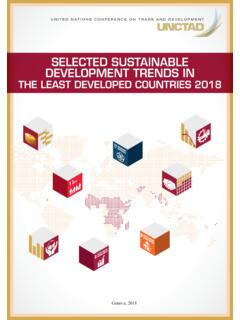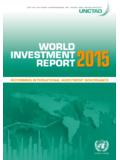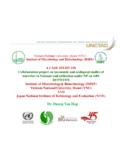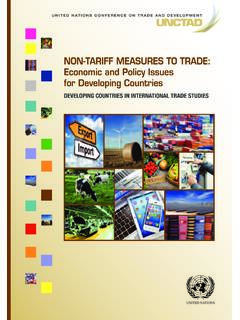Transcription of Review of Maritime Transport 2020 - Home | UNCTAD
1 INTERNATIONAL Maritime TRADEAND PORT TRAFFIC1 Growth in international Maritime trade stalled in 2019, reaching its lowest level since the global financial crisis of 2008 2009. Lingering trade tensions and high policy uncertainty undermined growth in global economic output and merchandise trade and by extension, Maritime trade. Maritime trade volumes expanded by per cent, down from per cent in 2018 and reached a total of billion tons in 2019. Growth in world gross domestic product slowed to per cent, down from per cent in 2018 and percentage point below the historical average over the 2001 2008 period.
2 In tandem, global merchandise trade contracted by per cent, as manufacturing activity came under pressure and the negative impact of trade tensions between the two largest world economies took a toll on investment and trade. Against the backdrop of a weaker 2019, the short-term prospects of Maritime Transport and trade darkened in early 2020. While initial expectations were that 2020 would bring moderate improvements in the economy and trade, the unprecedented global health and economic crisis triggered by the COVID-19 pandemic severely affected the outlook.
3 The fallout on Maritime Transport and trade was dramatic, with all economic indicators pointing downward. Taking into account the prevailing and persistent uncertainty, UNCTAD estimates that the volume of international Maritime trade will fall by per cent in 2020. Predicting the timing and scale of the recovery is also challenging, as many factors can significantly influence the outlook. Bearing this in mind, UNCTAD projections indicate that Maritime trade will recover in 2021 and expand by per the debate on the recovery continues to evolve, it is becoming clear that disruptions caused by the COVID-19 pandemic will have a lasting impact on shipping and trade.
4 These disruptions may trigger deep shifts in the overall operating landscape, together with a heightened sustainability and resilience-building imperative. Potential shifts range from changes in globalization patterns to alterations in supply-chain design, just-in-time production models, technology uptake and consumer spending habits. Depending on how these patterns unfold and interact, the implications for Maritime Transport can be transformational. Further, risk assessment and management, as well as resilience-building to future-proof supply chains and Maritime Transport , are likely to feature more prominently on policy and business agendas.
5 While Maritime Transport could emerge as a catalyst supporting some of these trends, it will also need to brace itself for change and adapt and ensure that it is also well prepared to enter the post -COVID-19 pandemic world. The Review of Maritime Transport 2020 is structured around five substantive chapters. Chapter 1 considers the demand for Maritime Transport services. Chapter 2 considers the factors that shape Maritime Transport infrastructure and services supply, including ship-carrying capacity, ports and related Maritime businesses.
6 Chapter 3 assesses the sector s performance using a set of indicators on port calls, port-waiting times, connectivity and the environmental sustainability of ships. Chapter 4 provides an overview of selected contributions received from various stakeholders, including government and industry, sharing experiences and lessons learned in connection with the pandemic. Chapter 5, the final chapter, presents key legal and regulatory developments, as well as trends in technology and innovation affecting Maritime Transport and trade.
7 The present chapter on international Maritime trade and port traffic reviews major developments in the world economy, merchandise trade, industrial activity and manufacturing supply chains that underpin demand for Maritime Transport infrastructure and services. Section A discusses volumes of international Maritime trade and port traffic and outlines key trends affecting Maritime trade in 2019. Section B focuses on the unprecedented health and economic global crisis triggered by the pandemic and considers its immediate impacts and its fallout on the varied shipping segments and ports , as well as its implications for the outlook of Maritime Transport and trade.
8 Section C concludes with some priority action areas with a view to ensuring the longer-term sustainability and resilience of Maritime Transport networks and supply OF Maritime Transport 2020A. VOLUME OF INTERNATIONAL Maritime TRADE AND PORT TRAFFIC1. Maritime trade lost momentum in 2019 and came under pressure in 2020 Owing to the slowdown in the world economy and trade, growth in international Maritime trade stalled in 2019 and reached its lowest level since the financial crisis of 2008 2009.
9 After rising moderately ( per cent) in 2018, volumes expanded at a marginal per cent in 2019. A number of factors weighed on the performance of Maritime trade. These included trade policy tensions; adverse economic conditions and social unrest in some countries; sanctions; supply-side disruptions, such as the Vale dam collapse in Brazil and Cyclone Veronica in Australia; and low oil demand growth. UNCTAD estimates the total volume of Maritime trade in 2019 at billion tons (tables and ).
10 As shown in figure , growth in Maritime trade decelerated in line with the slowdown in world GDP growth. Data also point to a negative outlook for 2020, with world GDP and Maritime trade projected to contract by per cent. The onset of the pandemic in early 2020 and its fallout on world economies, travel, Transport and consumption patterns, as well as manufacturing activity and supply chains, are causing a global recession in 2020. See section C for a more detailed discussion on the pandemic and its implications for Maritime Transport and Negative trends in the world economy and trade put a dent in international Maritime trade Shipping is a derived demand largely determined by developments in the world economy and trade.
